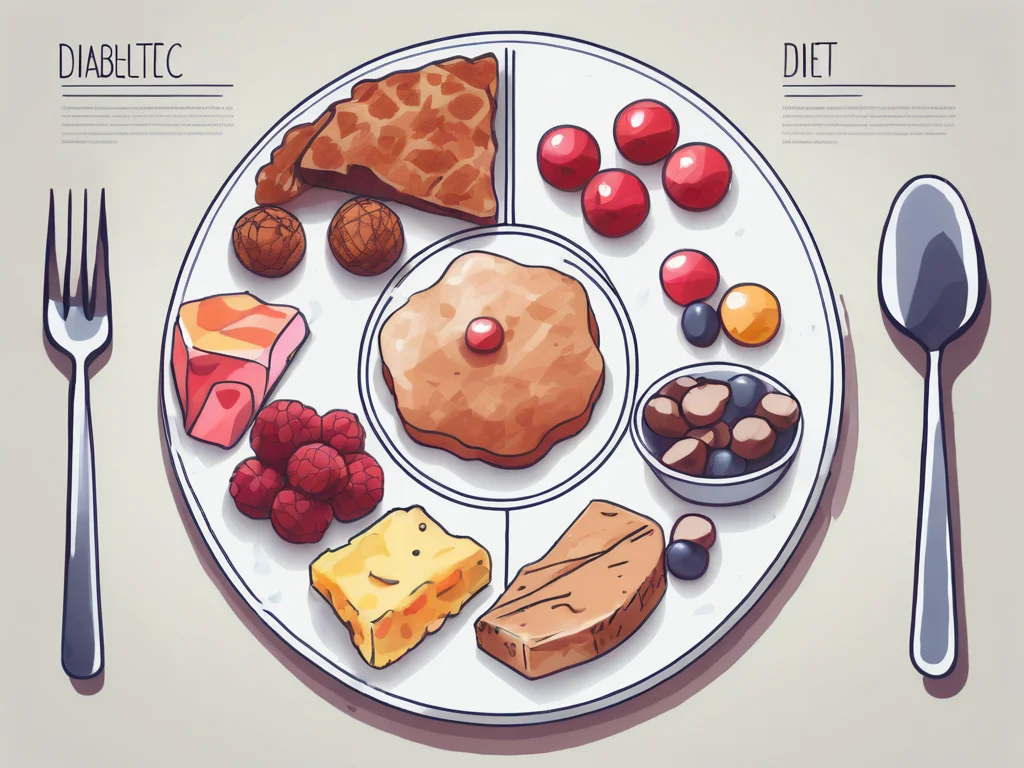Managing diabetes effectively requires a well-planned diet that stabilizes blood sugar levels and supports overall health. A balanced diabetic diet chart emphasizes nutrient-rich foods, portion control, and meal timing to prevent complications and promote well-being. This comprehensive guide explores how to create an effective diet plan for diabetic patients, including foods to include, foods to avoid, and practical tips for meal planning. By understanding the role of carbohydrates, fiber, and healthy fats, you can take control of diabetes and lead a healthier life.
Understanding Diabetes and Nutrition
How Does Nutrition Impact Diabetes?
Nutrition plays a pivotal role in managing diabetes, a chronic condition where the body struggles to regulate blood sugar levels. A well-structured diet helps control glucose spikes, reduces the risk of complications like heart disease, and supports overall health. The key is to focus on balanced meals that include the right mix of carbohydrates, proteins, and fats while prioritizing nutrient-dense, low-glycemic foods.
Why Are Carbohydrates Important for Diabetics?
Carbohydrates directly affect blood sugar levels as they break down into glucose during digestion. Choosing complex carbohydrates with a low glycemic index (GI) is essential for diabetic patients. Low-GI foods, such as whole grains, legumes, and non-starchy vegetables, release glucose slowly, preventing sudden blood sugar spikes. In contrast, high-GI foods like white bread and sugary snacks cause rapid glucose surges, which can be harmful.
What Is the Role of Fiber in a Diabetic Diet?
Fiber, a non-digestible carbohydrate, is a cornerstone of a diabetic diet. It slows glucose absorption, helping maintain stable blood sugar levels. Soluble fiber, found in oats, barley, and legumes, also lowers cholesterol, reducing the risk of cardiovascular issues—a common concern for diabetics. High-fiber foods like whole grains, fruits, and vegetables promote healthy digestion and support weight management.
How Do Fats Affect Blood Sugar and Diabetes?
Fats are essential but must be chosen wisely. Healthy fats, such as monounsaturated and polyunsaturated fats found in avocados, nuts, seeds, and fatty fish, improve insulin sensitivity and heart health. Conversely, saturated and trans fats, present in fried foods and processed snacks, can elevate cholesterol and increase heart disease risk. Portion control is crucial, as even healthy fats are calorie-dense.
Building an Effective Diabetic Diet Chart
Why Is Meal Planning Essential for Diabetics?
Meal planning is the foundation of a successful diabetic diet. It ensures a balance of carbohydrates, proteins, and fats while providing essential nutrients. A well-planned diet chart helps stabilize blood sugar, prevents overeating, and supports consistent energy levels. Working with a dietitian to create a personalized plan tailored to your needs is highly recommended.
How Does Portion Control Help Manage Diabetes?
Portion control is critical for preventing blood sugar spikes and maintaining stable glucose levels. Overeating, even healthy foods, can lead to hyperglycemia, while undereating may cause hypoglycemia. Use tools like measuring cups or a food scale to monitor portions, and pay attention to hunger and fullness cues to find the right balance.
Why Does Meal Timing Matter for Blood Sugar Control?
Consistent meal timing helps regulate blood sugar levels and prevents extreme fluctuations. Spacing meals evenly throughout the day—typically every 3-4 hours—avoids prolonged fasting periods that can disrupt glucose balance. Avoid skipping meals, as this can lead to overeating later or low blood sugar episodes.
Foods to Include in a Diabetic Diet
Why Are Whole Grains Beneficial for Diabetics?
Whole grains are rich in fiber, antioxidants, and phytochemicals, making them ideal for blood sugar control. Unlike refined grains, whole grains like brown rice, quinoa, oats, and whole wheat bread digest slowly, preventing rapid glucose spikes. They also reduce inflammation and lower the risk of chronic diseases like heart disease and cancer.
What Are the Benefits of Lean Proteins for Diabetics?
Lean proteins, such as skinless poultry, fish, tofu, beans, and legumes, stabilize blood sugar and promote satiety. They provide essential amino acids for muscle repair and improve insulin sensitivity. Low in saturated fats, these protein sources support heart health, which is critical for diabetics who face a higher risk of cardiovascular issues.
Why Are Fruits and Vegetables Essential for Diabetics?
Fruits and vegetables are low in calories and high in fiber, vitamins, and minerals, making them perfect for a diabetic diet. Their vibrant colors indicate phytonutrients like flavonoids and carotenoids, which offer antioxidant and anti-inflammatory benefits. Non-starchy vegetables (e.g., spinach, broccoli) and low-GI fruits (e.g., berries, apples) help manage blood sugar effectively.
Foods to Avoid in a Diabetic Diet
Why Should Diabetics Avoid Processed Foods?
Processed foods, such as sugary cereals, packaged snacks, and fast food, are high in refined carbohydrates, unhealthy fats, and added sugars. These cause rapid blood sugar spikes and provide little nutritional value. Opt for whole, unprocessed foods to maintain stable glucose levels and improve overall health.
How Do Sugary Drinks Affect Diabetes?
Sugary drinks like soda, fruit juices, and sweetened beverages are loaded with added sugars that spike blood sugar rapidly. They offer minimal nutritional benefits and can contribute to weight gain. Diabetics should prioritize water, unsweetened teas, or sugar-free alternatives to stay hydrated without affecting glucose levels.
Why Are High-Fat Foods Harmful for Diabetics?
High-fat foods, particularly those rich in saturated and trans fats (e.g., butter, full-fat dairy, fried foods), increase cholesterol levels and heart disease risk. Diabetics should limit these foods and choose healthy fats from avocados, nuts, and olive oil to support insulin sensitivity and cardiovascular health.
Practical Tips for Creating a Diabetic Diet Chart
- Prioritize Low-GI Foods: Choose whole grains, legumes, and non-starchy vegetables to keep blood sugar stable.
- Incorporate Lean Proteins: Include poultry, fish, tofu, or beans in every meal for satiety and muscle health.
- Add Colorful Fruits and Vegetables: Aim for a variety of colors to maximize nutrient intake and antioxidant benefits.
- Practice Portion Control: Use measuring tools and listen to your body’s hunger cues to avoid overeating.
- Stick to a Meal Schedule: Eat every 3-4 hours to maintain consistent blood sugar levels.
- Limit Processed and Sugary Foods: Avoid refined carbs, sugary drinks, and high-fat foods to prevent glucose spikes.
- Consult a Dietitian: Work with a professional to tailor a diet plan to your specific needs and lifestyle.
Sample Diabetic Diet Chart
Breakfast
- 1/2 cup cooked oats with berries
- 1 boiled egg or 1/4 cup tofu
- 1 cup unsweetened green tea
Mid-Morning Snack
- 1 small apple
- 10-12 almonds
Lunch
- 1 cup quinoa or brown rice
- 3 oz grilled chicken or lentils
- 1 cup steamed broccoli and carrots
- 1 tbsp olive oil dressing
Afternoon Snack
- 1/2 cup Greek yogurt (unsweetened)
- A handful of baby spinach
Dinner
- 3 oz baked salmon or chickpeas
- 1 cup roasted non-starchy vegetables (zucchini, bell peppers)
- 1 small whole-grain roll
Evening Snack
- 1 slice whole-grain bread with avocado
- 1 cup herbal tea
Conclusion
A well-structured diabetic diet chart is a powerful tool for managing blood sugar levels and preventing complications. By focusing on low-GI carbohydrates, fiber-rich foods, lean proteins, and healthy fats, diabetic patients can achieve better glucose control and improve overall health. Avoiding processed foods, sugary drinks, and high-fat foods is equally important to maintain stable blood sugar and reduce heart disease risk. With proper meal planning, portion control, and consistent meal timing, you can take charge of your diabetes and lead a fulfilling life. Consult a healthcare professional or registered dietitian to create a personalized diet plan tailored to your needs.



